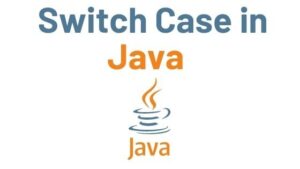We are creating a simple calculator in this program that performs addition, subtraction, multiplication, and division based on user input. The program takes the value of both numbers (entered by the user) and then asks the user to enter the operation (+, -, *, and /), and based on the input, the program performs the selected operation on the entered numbers using a switch case.
Example: To make a calculator using switch case in Java
import java.util.Scanner;
public class JavaExample {
public static void main(String[] args) {
double num1, num2;
Scanner scanner = new Scanner(System.in);
System.out.print("Enter first number:");
/* We are using data type double so that user
* can enter integer as well as floating point
* value
*/
num1 = scanner.nextDouble();
System.out.print("Enter second number:");
num2 = scanner.nextDouble();
System.out.print("Enter an operator (+, -, *, /): ");
char operator = scanner.next().charAt(0);
scanner.close();
double output;
switch(operator)
{
case '+':
output = num1 + num2;
break;
case '-':
output = num1 - num2;
break;
case '*':
output = num1 * num2;
break;
case '/':
output = num1 / num2;
break;
/* If user enters any other operator or char apart from
* +, -, * and /, then display an error message to user
*
*/
default:
System.out.printf("You have entered wrong operator");
return;
}
System.out.println(num1+" "+operator+" "+num2+": "+output);
}
}
Output:
Enter first number:30
Enter second number:3
Enter an operator (+, -, *, /): /
30.0 / 3.0: 10.0
obtain a system’s IP address obtain a system’s IP address obtain a system’s IP address obtain a system’s IP address obtain a system’s IP address obtain a system’s IP address v obtain a system’s IP address obtain a system’s IP address obtain a system’s IP address
Fibonacci sequence Fibonacci sequence v Fibonacci sequence v Fibonacci sequence v Fibonacci sequence vFibonacci sequence
simple calculator simple calculator simple calculator simple calculator simple calculator simple calculator simple calculator simple calculator
In Java, encapsulation is a mechanism for combining variables (data) and methods (code) into a single unit. It is the process of concealing information details and safeguarding the object’s data and behavior. It’s one of the four key concepts in OOP. Because the encapsulating class is simple to test, it’s ideal for unit testing.In Java, encapsulation is a mechanism for combining variables (data) and methods (code) into a single unit. It is the process of concealing information details and safeguarding the object’s data and behavior. It’s one of the four key concepts in OOP. Because the encapsulating class is simple to test, it’s ideal for unit testing.In Java, encapsulation is a mechanism for combining variables (data) and methods (code) into a single unit. It is the process of concealing information details and safeguarding the object’s data and behavior. It’s one of the four key concepts in OOP. Because the encapsulating class is simple to test, it’s ideal for unit testing.In Java, encapsulation is a mechanism for combining variables (data) and methods (code) into a single unit. It is the process of concealing information details and safeguarding the object’s data and behavior. It’s one of the four key concepts in OOP. Because the encapsulating class is simple to test, it’s ideal for unit testing.In Java, encapsulation is a mechanism for combining variables (data) and methods (code) into a single unit. It is the process of concealing information details and safeguarding the object’s data and behavior. It’s one of the four key concepts in OOP. Because the encapsulating class is simple to test, it’s ideal for unit testing.In Java, encapsulation is a mechanism for combining variables (data) and methods (code) into a single unit. It is the process of concealing information details and safeguarding the object’s data and behavior. It’s one of the four key concepts in OOP. Because the encapsulating class is simple to test, it’s ideal for unit testing.In Java, encapsulation is a mechanism for combining variables (data) and methods (code) into a single unit. It is the process of concealing information details and safeguarding the object’s data and behavior. It’s one of the four key concepts in OOP. Because the encapsulating class is simple to test, it’s ideal for unit testing.In Java, encapsulation is a mechanism for combining variables (data) and methods (code) into a single unit. It is the process of concealing information details and safeguarding the object’s data and behavior. It’s one of the four key concepts in OOP. Because the encapsulating class is simple to test, it’s ideal for unit testing.In Java, encapsulation is a mechanism for combining variables (data) and methods (code) into a single unit. It is the process of concealing information details and safeguarding the object’s data and behavior. It’s one of the four key concepts in OOP. Because the encapsulating class is simple to test, it’s ideal for unit testing. sum the elements of an array sum the elements of an array sum the elements of an array sum the elements of an array sum the elements of an array sum the elements of an array sum the elements of an array sum the elements of an array sum the elements of an array sum the elements of an array sum the elements of an array sum the elements of an array convert a char array convert a char array convert a char array vv convert a char array vconvert a char array



